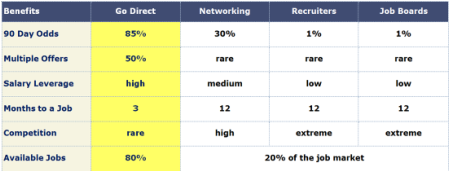We all know that networking is an essential part of an effective job search campaign, but it’s not like throwing some A-1 on a steak. To get the most out of it, there needs to be a plan, well executed, just like any good military operation.
- Where – You need to focus on where to meet hiring managers and other key personnel for companies you’re targeting away from the office (see “Personal Branding” http://bit.ly/L9XzaF). These opportunities (trade shows, industry professional organizations, company support work at charitable events) can often be found on LinkedIn profiles and company websites.
- Planning – Arrive early and offer to help setup (if appropriate). There will be fewer people then and they will appreciate your help. If you travel there with another job seeker, fine, but then split up. You need to follow your own path and it’s easier to approach potential contacts that way.
- Business Cards - You’ll need a handful of business cards that you can have made locally at business supply stores or on-line from Vista Print, Zazzle, GotPrint, and others. Write comments on the back of business cards you collect right away. This information should include date, event, and any interesting observations of that person to avoid a memory lapse later.
- At the Events – Be well informed about the latest company news, new product lines, and developments so that you can ask informed questions. You need to actively engage people to establish a reputation and create valuable relationships (which is largely why we network anyway). Look for individuals who may be alone and introduce yourself to them. They’d probably enjoy having someone speak with. Once you’ve learned what you can from that person, you need to move on. Don’t directly ask anyone for a job (though some events have open jobs posted nearby), simply say that you’re in transition and ask for advice and referrals to get a warm follow-up.
- Follow-up – Email those you met, comment on your meeting to remind them who you are, and ask to connect on LinkedIn. Follow-up with referrals.

 RSS Feed
RSS Feed